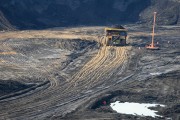As the world’s fourth-largest producer of crude oil, Canada’s rising oil production has been a source of economic growth but also a primary driver for Canada’s overall carbon emissions. Canadians have been told for a decade that oil and gas are getting cleaner. So it might come as a surprise that while the emissions intensity of Canada’s oil has been improving recently, it is still only marginally better than it was in 2005 (emissions intensity is 13% lower) and, according to the latest National Inventory Report, is higher today than it was in 1990 by 9% (Figure 1). This is mostly due to the increasing share of oilsands production in the industry.
Both absolute (or total) emissions as well as emissions intensity (or per-unit emissions) are critically required in reporting and tracking progress. To compare progress on different oil production methods, we use emissions intensity as a normalized metric. See our report Getting on Track (p. 20-23) for more details.
Why does this matter? Carbon emissions intensity indicates the amount of GHG emissions that are produced on average, industry-wide, to extract one barrel of oil. The emissions associated with producing a barrel of oil is a critical indicator of the carbon competitiveness of Canada’s oil assets.
While the majority Canadian crude oil production is exported to the United States, the emissions associated with the development, extraction, and processing of crude oil in Canada are counted under Canada’s share of greenhouse gas (GHG) emissions, as reported in its National Inventory Report. The same report shows that emissions from oil production accounted for 16% of Canada’s emissions in 2021.

Progress in oil production carbon intensity in Canada is mixed
A deeper dive into the different types of oil production shows mixed results. There have been notable improvements in some production types. For example, emissions from heavy oil were historically dominated by a high level of venting. As venting regulations and practices improved, heavy oil emissions intensity has dropped by half when compared to 2005 levels. However, during the same period, the emissions intensity from oilsands produced using in-situ cyclic steam stimulation (CSS) increased by 43% (Figure 2).

Canadian oil production now dominated by oilsands
The early years of oil production in Canada were dominated by light conventional barrels produced with vertical wells, which meant a lower emission intensity per barrel produced. As the easier-to-produce reservoirs were depleted, production shifted to more complex and a more energy-intensive methods, such as oilsands mining and in-situ operations.
The growth of the oilsands in more recent decades, with higher emissions intensity than conventional oil, shifted the overall average intensity of Canadian production higher. The share of oilsands production increased from only 27% in 2000 to 65% in early 2023 (Figure 3).

The International Energy Agency (IEA) recently published a special report to inform the discussion on oil and gas emission reduction opportunities in the lead-up to COP28 in Dubai. This report shows that emissions intensity from oil and gas operations needs to be reduced by 50% by 2030 compared to 2022 levels, and outlines the top key levers to achieve this goal (explicitly not including offsets):
- Tackling methane emissions
- Eliminating all non-emergency flaring
- Electrifying upstream facilities with low-emissions electricity
- Equipping oil and gas processes with carbon capture, utilisation and storage (CCUS)
Producers that show the clearest path to reducing emissions in 2030 will have a carbon competitiveness advantage as the world shifts away from oil on the path to net-zero. Canada and the majority of the world are now committed to net-zero, and momentum continues to build each year. The Canada Energy Regulator’s recent Energy Future report shows that if Canada and the world achieve net-zero, Canadian oil production will peak in 2026 and decline by 76% by 2050. As the world progresses towards net-zero, oil markets will only become more competitive, not just on cost, but on carbon as well, There is still significant work ahead for Canadian producers to improve carbon competitiveness. The emissions reduction plans put forward by the oilsands companies as part of the Pathways Alliance are a critical part of this path, as are policies such as methane regulations and the federal oil and gas cap.










